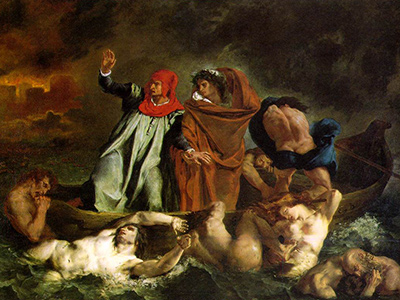Delacroix painted The Barque of Dante in a frantic two month stint to get it ready for the Salon of 1822.
It was his first major painting, and it shows the decisive move from neo-classicism to Romanticism.
Not all the critics understood what Delacroix was trying to do, and the painting received conflicting reviews, alternatively hailed as a masterpiece or dismissed as a 'daub'.
The painting shows a scene from Dante's Inferno; Dante and Virgil are crossing the River Styx in hell, while damned souls clutch at the boat in an attempt to escape their torments.
While the pyramidal massing of the figures reflects neo-classical style, Delacroix' landscape shows a clear romantic sensibility.
He lets his imagination loose; the city of Dis becomes a glowing, roaring furnace, while smoke, waves, gloom, and darkness contrast with the bold colours of Dante's and Virgil's draperies.
The pallid, corpse-like tones of the damned souls provide a further colour contrast.
The theme of men clutching at a precarious boat to try to save themselves reflects a painting Delacroix would have seen a few years earlier, Gericault's Raft of the Medusa.
He even seems to have borrowed one of the faces from Gericault's painting. But while Gericault showed a real event, Delacroix is showing a mythical world.
He would not be the last Romantic painter to take his inspiration from Dante; Gustave Doré illustrated the entire text with his gloomy and intense engravings, and in England William Blake showed Dante entering the flames.
The painting concentrates on intense emotion; the faces of the damned souls reflect anger and horror, and their bories are contorted, while Dante is clearly terrified, throwing his arms in the air.
Only Virgil, gently holding Dante's hand, is a calming influence (his static saffron robe contrasting with the jagged highlights of Dante's pale blue one). Delacroix has created a striking and memorable image. In future years he was to paint many more.




